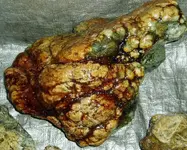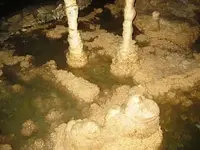Cave coral is an interesting guess, but I still am leaning on botroidal quartz. That is the official name of knobby formation. This could have come from a hard rock mining area. I have found pieces similar in the Rockies above Leadville. Just for the record, there aren't too many Rockies higher than Leadville, but some.
A scratch test will tell. Find a piece of calcite. If it scratches the subject, then maybe. But if the same piece doesn't scratch quartz, then one knows for sure. I know, cave coral is a different formation than massive or crystalline calcite, but is is a start. Or, take a piece of the subject and put it in acid. Vinegar is slow, sulphuric acid from an old battery is dangerous, but you decide. Quartz won't be affected by vinegar. The brown stains could be from mineralization in the hard rock.
This is why I said cave coral is an interesting guess based on the photo. All the points were as applicable as mine for quartz.
My second guess would be the alligator neck.










